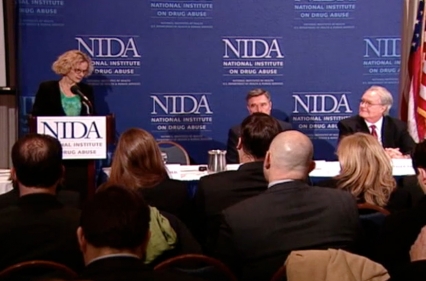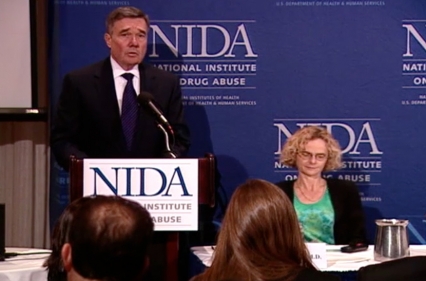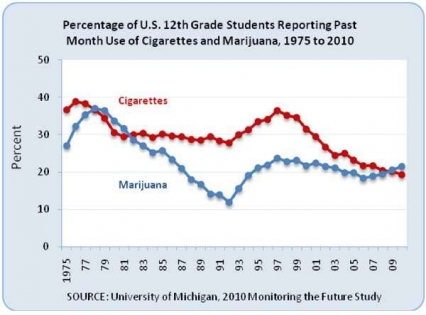This year's Monitoring the Future Survey raises concerns about increases in drug use among the Nation's teens, particularly the youngest.
- Daily Marijuana use increased among 8th, 10th, and 12th graders from 2009 to 2010. Among 12th graders it was at its highest point since the early 1980's at 6.1%. This year, perceived risk of regular marijuana use also declined among 10th and 12th graders suggesting future trends in use may continue upward.
- In addition, most measures of marijuana use increased among 8th graders between 2009 and 2010 (past year, past month, and daily), paralleling softening attitudes for the last 2 years about the risk of using marijuana.
- Marijuana use is now ahead of cigarette smoking on some measures (due to decreases in smoking and recent increases in marijuana use). In 2010, 21.4 percent of high school seniors used marijuana in the past 30 days, while 19.2 percent smoked cigarettes.
- Steady declines in cigarette smoking appear to have stalled in all three grades after several years of improvement on most measures.
- After marijuana, prescription and over-the-counter medications account for most of the top drugs abused by 12th graders in the past year. Among 12th graders, past year non-medical use of Vicodin decreased from 9.7% to 8%. However, past year non-medical use of OxyContin remains unchanged across the three grades and has increased in 10th graders over the past 5 years. Moreover, past-year nonmedical use of Adderall and over-the-counter cough and cold medicines among 12th graders remains high at 6.5% and 6.6%, respectively.
- After several years of decline, current and past year use of Ecstasy has risen among 8th and 10th graders. From 2009 to 2010, lifetime use of ecstasy among 8th graders increased from 2.2% to 3.3%, past year use from 1.3% to 2.4%, and current use 0.6% to 1.1%. This follows declines in perceived risk associated with MDMA use seen over the past several years.
- Alcohol use has continued to decline among high school seniors with past-month use falling from 43.5% to 41.2% and alcohol binge drinking (defined as 5 or more drinks in a row in the past 2 weeks) declining from 25.2% to 23.2%. Declines were also observed for all measures among 12th graders reporting the use of flavored alcoholic beverages. Past year use fell from 53.4% to 47.9%.
This is also available in PDF format. Download (PDF, 209KB)
- Text Description: Percentage of U.S. 12th Grade Students Reporting Past Month Use of Cigarettes and Marijuana, 1975 to 2009
-
Year 1975: Cigarettes 36.7, Marijuana 27.1
Year 1976: Cigarettes 38.8, Marijuana 32.2
Year 1977: Cigarettes 38.4, Marijuana 35.4
Year 1978: Cigarettes 36.7, Marijuana 37.1
Year 1979: Cigarettes 34.4, Marijuana 36.5
Year 1980: Cigarettes 30.5, Marijuana 33.7
Year 1981: Cigarettes 29.4, Marijuana 31.6
Year 1982: Cigarettes 30.0, Marijuana 28.5
Year 1983: Cigarettes 30.3, Marijuana 27.0
Year 1984: Cigarettes 29.3, Marijuana 25.2
Year 1985: Cigarettes 30.1, Marijuana 25.7
Year 1986: Cigarettes 29.6, Marijuana 23.4
Year 1987: Cigarettes 29.4, Marijuana 21.0
Year 1988: Cigarettes 28.7, Marijuana 18.0
Year 1989: Cigarettes 28.6, Marijuana 16.7
Year 1990: Cigarettes 29.4, Marijuana 14.0
Year 1991: Cigarettes 28.3, Marijuana 13.8
Year 1992: Cigarettes 27.8, Marijuana 11.9
Year 1993: Cigarettes 29.9, Marijuana 15.5
Year 1994: Cigarettes 31.2, Marijuana 19.0
Year 1995: Cigarettes 33.5, Marijuana 21.2
Year 1996: Cigarettes 34.0, Marijuana 21.9
Year 1997: Cigarettes 36.5, Marijuana 23.7
Year 1998: Cigarettes 35.1, Marijuana 22.8
Year 1999: Cigarettes 34.6, Marijuana 23.1
Year 2000: Cigarettes 31.4, Marijuana 21.6
Year 2001: Cigarettes 29.5, Marijuana 22.4
Year 2002: Cigarettes 26.7, Marijuana 21.5
Year 2003: Cigarettes 24.4, Marijuana 21.2
Year 2004: Cigarettes 25.0, Marijuana 19.9
Year 2005: Cigarettes 23.2, Marijuana 19.8
Year 2006: Cigarettes 21.6, Marijuana 18.3
Year 2007: Cigarettes 21.6, Marijuana 18.8
Year 2008: Cigarettes 20.4, Marijuana 19.4
Year 2009: Cigarettes 20.1, Marijuana 20.6
Year 2010: Cigarettes 19.2, Marijuana 21.4
- Transcript
-
Dr. Nora Volkow on increase in daily marijuana use among all grades.
Particularly important is that we're observing an increase on daily use of marijuana across all of the school grades, 8th, 10th, and 12th, and these increases go between 10 to 18 percent, so they are very large for a one-year period.
It is problematic because daily marijuana use is the one that leads to greater pathology and it could be estimated that between 25 and 50 percent of these daily marijuana using kids are likely to be dependent on the drug.
Dr. Nora Volkow on increase in marijuana use (and decrease in perceived harmfulness) among 8th graders.
And what we know, for example from epidemiological studies, is that those kids that start taking marijuana before age 17 are much more likely to become dependent, not just on marijuana, but on a wide variety of different drugs.
So observing these significant increases in the eighth graders is actually quite worrisome.
Dr. Nora Volkow on the implications of this year’s survey results.
So, the question is do we want a nation of kids that are abusing marijuana and getting mellow and interfering with their ability to study and perform or do we want to have kids really engaged on activities and excited and driven and to me that's a crucial issue for us because our nation, of course, relies on its new generation to build itself up into the future.
Dr. Nora Volkow on past month marijuana use exceeding cigarette use among 12th graders.
We're observing now that marijuana is going up whereas cigarette smoking though it has not continued to go down, it has stabilized, is that if you look at the indicator of past month use, there are more marijuana cigarette smokers in 12th grade than nicotine cigarette smokers.
Dr. Nora Volkow on increase of Ecstasy use among 8th and 10th graders, and the importance of prevention campaigns.
Unfortunately this year on the survey we're seeing a significant increase in the use of Ecstasy in 8th and 10th graders which may reflect, we believe, the lack of attention on this drug since we have been, I guess, become complacent by the fact that the rate of the use of this drug had gone down very, very dramatically.
The fact that we're seeing it rising again highlights the importance of prevention campaigns that do not ignore this particular type of drug.
Dr. Nora Volkow on trends in prescription drugs for non-medical use.
For the first time, we're seeing this year a significant decrease in the past year use of Vicodin, which is a pain medication, among 12th graders. Unfortunately, the rest of the indicators remain very high like Oxycotin over 5%, amphetamines over 7%, and Adderall over 5%. So all of those are very, very high rates of abuse of psychotherapeutics.
Images from Press Conference

NIDA Director Nora D. Volkow, M.D. discusses the 2010 Monitoring the Future survey results at a press conference Tuesday, December 14, 2010 at the National Press Club. Seated next to the podium are R. Gil Kerlikowske, ONDCP Director (center), and Dr. Lloyd Johnston, survey principal investigator.

Press conference attendees.

ONDCP Director R. Gil Kerlikowske takes a question from a reporter. Seated beside him is NIDA Director Nora D. Volkow, M.D.
